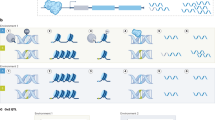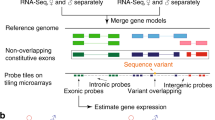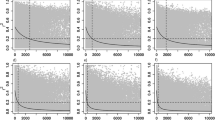Abstract
Central to the study of life cycle evolution is the concept of genetic trade-offs. Genetic trade-offs between life cycle characters develop as a result of the accumulation of genes with antagonistic pleiotropic effects. In the present study a comparison was made between the genetic architecture that had evolved in the ancestral environment and the way that this genetic architecture was disrupted following transfer to a new environment. It was predicted that, in the ancestral environment, genetic trade-offs should have evolved between each life cycle character and, as a result of these genetic trade-offs, significant levels of additive genetic variation should remain despite many generations of selection.
Following transfer to a new environment different genes might be expressed. Therefore, it was predicted that in the new environment the levels of additive genetic variation should increase and that the genetic trade-offs should break down. The predictions were well supported by the data.
Similar content being viewed by others
Article PDF
References
Arvesen, J M, and Schmitz, T H. 1970. Robust procedures for variance components problems using the jackknife. Biometrica, 26, 677–686.
Becker, W A. 1967. Manual of Quantitative Genetics (2nd edn). Washington State University, Washington.
Bell, G. 1984a. Measuring the cost of reproduction. I. The correlation structure of the life table of a plankton rotifer. Evolution, 38, 300–313.
Bell, G. 1984b. Measuring the cost of reproduction. II. The correlation structure of the life tables of five freshwater invertebrates. Evolution, 38, 314–326.
Bell, G, and Koufopanou, V. 1986. The Cost of Reproduction. In Dawkins, R. and Ridley, M. (eds) Oxford Surveys in Evolutionary Biology, vol.3. Oxford University Press, New York. pp. 83–131.
Champ, B R. 1967. The inheritance of DDT resistance in Sitophilus oryzae (L.) (Coleoptera, Curculionidae). J stored Prod Res, 4, 175–178.
Champ, B R, and Dyte, C E. 1976. Report of the FAO global survey of pesticide susceptibility of stored grain pests. FAO plant production and protection series no. 5. Rome.
Coombs, C W, Billings, C J, and Porter, J E. 1977. The Effect of Yellow Split-Peas (Pisum Sativum L.) and Other Pulses On The Productivity of Certain Strains of Sitophilus Oryzae (L.) (Col. Curculionidae) and The Ability of Other Strains To Breed Thereon. J Stored Prod Res, 13, 53–58.
Diaconis, P, and Efron, B. 1983. Computer intensive methods in statistics. Se Amer, 248, No 5, 96–108.
Efron, B. 1982. The jackknife, the bootstrap and other resampling plans. Society for Industrial and Applied Mathematics., 93 p.
Efron, B, and Gong, G. 1983. A leasurely look at the bootstrap, the jackknife and cross-validation. Amer Statist, 37, 36–48.
Evans, D E. 1982. The influence of temperature and grain moisture content on the intrinsic rate of increase of Sitophilus oryzae (L.). J stored Prod Res, 18, 55–66.
Falconer, D S. 1981. Introduction to Quantitative Genetics (2nd edn). Longman, London.
Giesel, J T, Murphy, P A, and Manlove, M N. 1982. The influence of temperature on genetic interrelationships of life-history traits in a population of Drosophila melanogaster: what tangled data sets we weave. Am Nat, U, 9, 464–479.
Giesel, J C, and Zettler, E E. 1980. Genetic correlations of life-historical parameters and certain fitness indices in Drosophila melanogaster: rm, rs and diet breadth. Oecologia, 47, 299–302.
Goodenough, U. 1978. Genetics (2nd edn). Holt, Rinehart and Winston, London.
Harborne, J B, Boulter, D, and Turner, B L. 1971. Chemotaxonomy of the Leguminosae. Academic Press Inc., London. 612 pp.
Heather, N W. 1986. Sex-linked resistance to pyrethroids in Sitophilus oryzae (L.) (Coleoptera: Curculionidae). J stored Prod Res, 22, 15–20.
Holloway, G J. 1984. Genetic Differentiation and Life History Variation in the Rice Weevil, Sitophilus oryzae. Ph.D. Thesis, University of Reading. pp218.
Holloway, G J. 1985. The effect of increased grain moisture content on some life history characters of Sitophilus oryzae after staining egg plugs with acid fuchsin. J stored Prod Res, 21, 165–169.
Holloway, G J. 1986a. The potency and effect of Phytotoxins within yellow split-pea (Pisum sativum) and adzuki bean (Vigna angularis) on survival and reproductive potential of Sitophilus oryzae. (Coleoptera: Curculionidae). Bull ent Res, 76, 287–295.
Holloway, G J. 1986b. A theoretical examination of the classical theory of inheritance of insecticide resistance and the genetics of time to knockdown and dry body weight in Sitophilus oryzae (L.) (Coleoptera: Curculionidae). Bull, ent Res, 76, 661–770.
Holloway, G J, and Mackness, M T. 1989. The evolutionary adaptation of enzyme systems in Sitophilus oryzae fed on toxic legumes. Ent exp appl, 48, 165–172.
Holloway, G J, and Smith, R H. 1985. Inheritance of the ability of Sitophilus oryzae (L.) (Coleoptera: Curculionidae) to feed and breed on yellow split-pea (Pisum sativum). Bull ent Res, 75, 367–375.
Krzanowski, W J. 1988. Principles of Multivariate Analysis. A Users Perspective. Clarenden Press, Oxford.
Luckinbill, L S, Arking, R, Clare, M J, Cirocco, W C, and Buck, S A. 1984. Selection For Delayed Senescence in Drosophila Melanogaster. Evolution, 38, 996–1003.
Mackay, C F C. 1985. A quantitative analysis of fitness and its components in Drosophila melanogaster. Genet Res, 47, 59–70.
Maccuaig, R D. 1956. Determination of resistance of locusts to DNC in relation to their weight, age and sex. Ann appl Biol, 44, 634–642.
Miller, R G. 1974. The jackknife- a review. Biometrika, 61, 1–15.
Møller, H, Smith, R H, and Sibly, R M. 1989. Evolutionary Demography of A Bruchid Beetle. I. Quantitative Genetical Analysis of The Female Life History. Fund Ecol, 3673–3681.
Murphy, P A, Giesel, J T, and Manlove, M N. 1983. Temperature Effects On Life History Variation in Drosophila Simulans. Evolution, 37, 1181–1192.
Povey, S R, Sibly, R M, and Holloway, G J. (in preparation) Evolution of insect life cycles in toxin-stressed environments: investigation of trade-offs using reciprocal transplant experiments.
Richards, O W. 1947. Observations on grain weevils Calandra (Col. Curculionidae). General Biology and oviposition. Proc Zool Soc Lond, 117, 1–43.
Rose, M R. 1982. Antagonistic pleiotropy, dominance and genetic variation. Heredity, 48, 63–78.
Rose, M R. 1984. Genetic covariance in Drosophila life history: untangling the data. Am Nat, 123, 565–569.
Rose, M R, and Charlesworth, B. 1981a. Genetics of life history in Drosophila melanogaster. I. Sib analysis of adult females. Genetics, 97, 173–186.
Rose, M R, and Charlesworth, B. 1981b. Genetics of life history in Drosophila melanogaster. II. Exploratory selection experiments. Genetics, 97, 187–196.
Searle, S R. 1971. Linear Models. John Wiley and Sons, New York.
Service, P M, and Rose, M R. 1985. Genetic covariation among life-history components: the effect of novel environments. Evolution, 39, 943–945.
Shazali, M E H. 1982. The Biology and Population Ecology of Four Insect Pests of Stored Sorghum with Particular Reference to Competition and Succession. Ph.D. Thesis, University of Reading.
Sibly, R M. 1989. What evolution maximizes. Fund Ecol, 3, 129–135.
Sibly, R M, and Calow, P. 1986. Physiological Ecology of Animals: an Evolutionary Approach. Blackwell, Oxford. pp179.
Simmons, M J, Preston, C R, and Engels, W R. 1980. Pleiotropic effects on fitness of mutations affecting viability in Drosophila melanogaster. Genetics, 94, 467–475.
Singh, S R, and Soderstrom, E L. 1963. Sexual selection of the rice weevil Sitophilus oryzae (L.) as indicated by sperm transfer and viable eggs. J Kans Ent Soc, 36, 32–34.
Sokal, R R, and Rohlf, F J. 1981. Biometry. W. H. Freeman and Co, San Francisco.
Soliman, M H. 1982. Directional and stabilizing selection for developmental time and correlated response in reproductive fitness in Tribolium castaneum. Theoret Appl Gen, 63, 111–116.
Stearns, S C. 1983. The Genetic Basis of Differences in Life History Traits Among Six Populations of Mosquito Fish (Gam- Busia Affinis) That Shared Common Ancestors in 1905. Evolution, 37, 618–627.
Strickberger, M W. 1968. Genetics. Collier Macmillan Ltd, London.
Thind, B B, and Muggleton, J. 1981. Inheritance of the ability of strains of Sitophilus oryzae (L.) (Coleoptera: Curculionidae) to breed on split-pea (Pisum sativum). Bull, ent Res, 71, 419–424.
Via, S. 1984. The quantitative genetics of polyphagy in an insect herbivore. I. Genotype-environment interaction in larval performance on different host plant species. Evolution, 38, 881–895.
Way, M J. 1954. The effect of body weight on the resistance to insecticide of the last instar larva of Diataraxia oleracea L., the tomato moth. Ann appl Biol, 47, 77–87.
Williams, G C. 1966. Natural selection, the costs of reproduction and a refinement of Lack's principle. Amer Nat, 100, 687–690.
Author information
Authors and Affiliations
Rights and permissions
About this article
Cite this article
Holloway, G., Povey, S. & Sibly, R. The effect of new environment on adapted genetic architecture. Heredity 64, 323–330 (1990). https://doi.org/10.1038/hdy.1990.40
Received:
Issue date:
DOI: https://doi.org/10.1038/hdy.1990.40
This article is cited by
-
The role of maternal effects on offspring performance in familiar and novel environments
Heredity (2021)
-
Rearing environment affects the genetic architecture and plasticity of DNA methylation in Chinook salmon
Heredity (2021)
-
Strong phenotypic plasticity limits potential for evolutionary responses to climate change
Nature Communications (2018)
-
Host genotype and age shape the leaf and root microbiomes of a wild perennial plant
Nature Communications (2016)
-
Complex Genotype by Environment interactions and changing genetic architectures across thermal environments in the Australian field cricket, Teleogryllus oceanicus
BMC Evolutionary Biology (2011)



